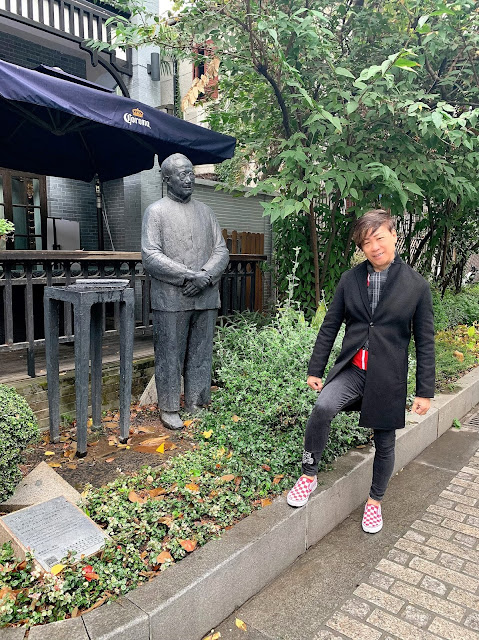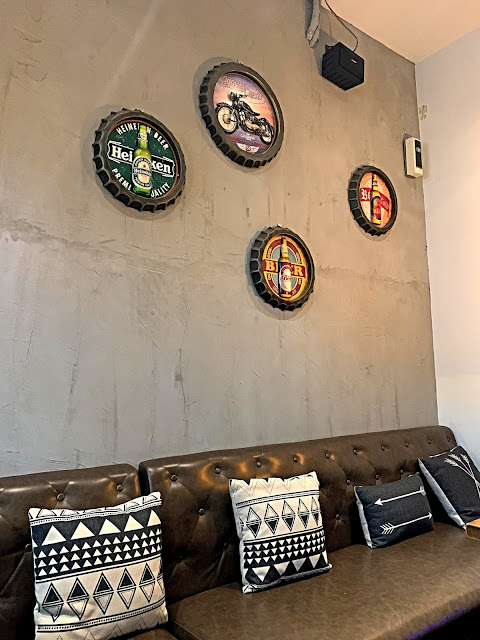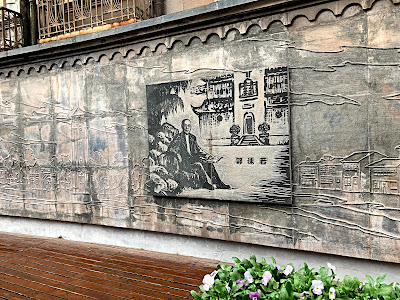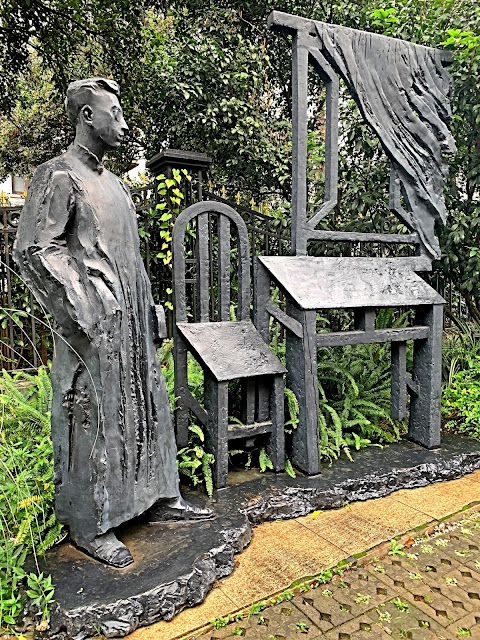I had read about Duolun Road and was curious about it. Seemed like a good one-day adventure. Checked the metro lines and goodness, it would take a good hour to reach the closest metro station to Duolun Road. OK! Let's do it.
From Pudong, we were on our home Line 13 Zhongke Road and had to stop at Chengshan Road to change to Line 8 and finally taking Line 8 to Hongkou Football Stadium station.
Unfortunately, upon arrival at the football stadium station, it started raining.
So we decided to take a long breakfast at McDonald's!
We took a cab to Duolun Road. Cost us 14¥
It was still drizzling but since we were already here, we made the best out of our walk.
Welcome to Duolun Cultural Road.
The locals call this road Duolun Lu.
This road was built in 1911. Duolun's goldren era was between 1920s and 1930s when it was a cultural hub in Shanghai, and was known as Darroch Road then. Along this road, there is a blend of Colonial style architecture and local Shanghai Chinese style. Today, Duolun road is lined with bookstores, art stores, antique shops, teahouses, historical residences and museums.

This building is a shopping complex; an old-fashioned 4 storey building that sells jade, antiques, art and jewellery.
Loved watching these gentlemen painting and enjoying life.
Museum of Modern Art
Lu Xun was the Father of Modern Literature. Born as Zhou Shuren, he was China's greatest modern writer for the most of the 20th Century. He was best known for his short stories. He published his first short story named Diary of a Madman in 1918; the first published Western styled story written in wholly in vernacular Chinese. He was a prolific writer of short biting essays against social injustice and political corruption. His lifelong dedication was to teach and encourage young people as the major hope for China's future.
Mao Dun, original name Shen Dehong, was considered as China's greatest realist novelist. He was famous for his psychological realism writing as well as short stories and prose. Mao Dun became the first Minister of Culture after the establishment of the communist government. Later on, he was elected as Chairman for the Chinese Writers' Association.
Jewellery store
Cun Bao Tang
A beautiful unique church that looks like a Chinese temple or palace.
Uchiyama Kanzo was Lu Xun's good friend. Kanzo's bookshop is the place for Asian literary modenism books. Kanzo is also Lu Xun's publisher.
Fogel, in his book, wrote about the fascinating and extraordinary friendship of Lu Xun and Kanzo. He talked about how this friendship between a highly educated left-wing writer and a bookshop owner loomed on the verge of a horrible war. Kanzo revered Lu Xun as a close friend; someone who shared conversations on a wide variety of political and cultural questions; someone who stood for human rights that Kanzo himself believed in.
(A Friend in Deed: Lu Xun, Uchiyama Kanzo, and the Intellectual World of Shanghai on the Eve of War " by Joshua A. Fogel)
Yi De Tang, an art store
Shen Yimo, a Chinese poet
Cafe
Ding Ling, pen name of Jiang Bingzhi, was one of China's most popular 20th Century short-story writers. Her partner was He Yupin, another writer. Ding Ling's writing was influenced by contemporary Chinese literary works and foreign literary masterpieces in which she developed a new kind of Chinese heroine - daring, passionate and independent. Later on, her writing converted to Marxism where she was more critical about the communist movement and women's rights. She was in political trouble for her open criticisms and had been imprisoned several times.
Duolun Road was originally known as the Darroch Road.
Time for a latte at the Darroch cafe! It is a cosy residence. Christmas decorations were up. Soft English oldies were in the background. They served a great variety of Western cuisine.
Darroch was a British missionary who built Darroch Road in 1911. The road was renamed Duolun Lu in 1943 after the People's Republic of China was established.
People's residence behind the tall gates
Old Film Cafe
When we were there, it was closed. However, there was work going on in the inside of the building. I prayed that they are improving on it and not tearing it down. This cafe was known to show old Chinese movies while customers enjoy a meal.
Is that a Charlie Chaplin statue?
Art shops
Ye Shengtao, original name Ye Shaojun, was a Chinese writer and teacher
Jingyunli
Once a safe home for the country's left-wing writers to live, work and avoid the Kuomintang's prosecution. Famous writers like Guo Moruo, Ye Shengtao, Mao Dun and Lu Xun used to call Jingyunli home from time to time.
A long mural featuring famous Chinese writers and intellects from 1920s - 1930s
Former quarters (dormitory) for University of China Arts, 1930
A teahouse
Former residence of Chen Zhongchi, 1920
Bai Chongxi's residence, 1924. Bai was a General of Republic of China and a prominent Chinese Nationalist Muslim leader.
Old textile shop and a teahouse
Rou Shi, a Chinese writer
The Five Matyrs
Rou Shi in the front surrounded by Hu Yepin, Feng Keng, Li Weisen and Yin Fu
Qu Qiubai, one of the leaders of the Communist Party in the late 1920s
Cafe
Cafe
People are still living here today!
The Kong Residence built by Kong Xiangxi (aka H. H. Kung) in 1924; the richest man in China in the early 20th Century and the husband of Soong Ai-Ling.
Navy Medical University for the soldiers of China
North Gate of Duolun Road
Lu Xun's Trail is about 1000 meters.
Walk his trail, appreciate the culture and comprehend his personality!





























































































































No comments:
Post a Comment